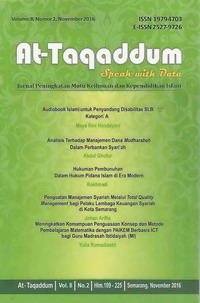HUKUMAN PEMBUNUHAN DALAM HUKUM PIDANA ISLAM DI ERA MODERN
DOI:
https://doi.org/10.21580/at.v8i2.1169Keywords:
Islamic Criminal Law, murder, and equality lawAbstract
Murder in the Islamic criminal law including jarimah qishas-diyat, namely jarimah punishable by qishas (punishment commensurate/proportional) or punishment diyat (fines/restitution), the specified limits his sentence, but is categorized as a right adami (human/individual), in which the victim or his family can forgive the perpetrators, so that the penalty (qishas-diyat) can remove altogether, because in qishas no entitlements for victims' families to act as "institutions forgiving", they can ask for their right to forgive or not forgive the criminal act. According to scholars' Salaf that the policy of punishment given is based on the viewpoint of the habit of Arab society that never applies to the Muslim community early, namely regarding who is authorized to determine the wisdom qishas or of diyat is heavily influenced by the practice habits of Arab society in the 7th century M, both about social status, as well as the local culture, the sunnah and the practice run early Muslims who provide input or benchmarks in detail the principles prinsp Islamic criminal law (jinayat), so that in determining the sentence still is discrimination, whether social status, gender and religion. Therefore, in the modern era according to scholars' khalaf that sentencing for murder should be equated between the murder of men with women, killing of Muslims by non-Muslims, the murder of a father with his son, should remain punishable qishas and diyat amount laki- men with diyat amount for women should be equal, so that the position of human beings are equal before the law (there is no discrimination; social status, gender and religion.Downloads
Downloads
Published
How to Cite
Issue
Section
License
The copyright of the received article shall be assigned to the journal as the publisher of the journal. The intended copyright includes the right to publish the article in various forms (including reprints). The journal maintains the publishing rights to the published articles. Therefore, the author must submit a statement of the Copyright Transfer Agreement.*)

This work is licensed under a Creative Commons Attribution-ShareAlike 4.0 International License.
In line with the license, authors and third parties (readers, researchers, and others) are allowed to share and adapt the material. In addition, the material must be given appropriate credit, provided with a link to the license, and indicated if changes were made. If authors remix, transform or build upon the material, authors must distribute their contributions under the same license as the original.
________
*) Authors whose articles are accepted for publication will receive confirmation via email and send a Copyright Transfer Agreement.











